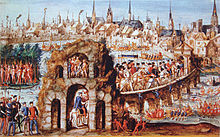Tupinambá people


The Tupinambá were one of the various Tupi ethnic groups that inhabited present-day Brazil before the conquest of the region by Portuguese colonial settlers. The Tupinambás lived in São Luis, Maranhão.[1] Their language survives today in the form of Nheengatu.
The Tupinambás were abundantly described in André Thevet's 1572 Cosmographie universelle (English: The New Found World, or Antarctike), in Jean de Léry's Histoire d'un voyage faict en la terre du Brésil (English: History of a Voyage to the Land of Brazil) (1578), and Hans Staden's Warhaftige Historia und beschreibung eyner Landtschafft der Wilden Nacketen (English: True History: An Account of Cannibal Captivity in Brazil), in which he describes the Tupinamba practicing cannibalism. Thevet and Léry were an inspiration for Montaigne's famous essay Des Cannibales,[2][3] and influenced the creation of the myth of the "noble savage" during the Enlightenment.
-
A Tupinambá named "Louis Henri" who visited Louis XIII in Paris in 1613, in Claude d'Abbeville, Histoire de la mission.
-
Catarina Paraguaçu, wife of Portuguese sailor Diogo Álvares Correia, in an 1871 painting
The Tupinambá may have given their name to the common French word for the Jerusalem Artichoke, the topinambour.[5]
References
- ^ "Map of Maranhao, City of São Luis do Maranhão". World Digital Library. Retrieved 27 April 2013.
- ^ Michel de Montaigne,Essais, Book 1, Chap.30
- ^ Carlo Ginzburg (2012)Threads and Traces: True, False, Fictive, (papers), University of California Press, ISBN 9780520274488, Chapter 3: Montaigne, Cannibals, and Grottoes
- ^ "True History and Description of a Country in America, whose Inhabitants are Savage, Naked, Very Godless and Cruel Man-Eaters". World Digital Library. Retrieved 26 April 2013.
- ^ Graham, Peter. "Chez Gram". Retrieved 17 February 2018.
Sources
- Léry, Jean, and Janet Whatley. History of a Voyage to the Land of Brazil, Otherwise Called America. Berkeley: University of California Press, 1990. Print.

![Original 1557 Hans Staden woodcut of the Tupinambá portrayed in a cannibalistic feast.[4]](http://upload.wikimedia.org/wikipedia/commons/thumb/8/8a/Hans_Staden%2C_Tupinamba_portrayed_in_cannibalistic_feast.jpg/111px-Hans_Staden%2C_Tupinamba_portrayed_in_cannibalistic_feast.jpg)

